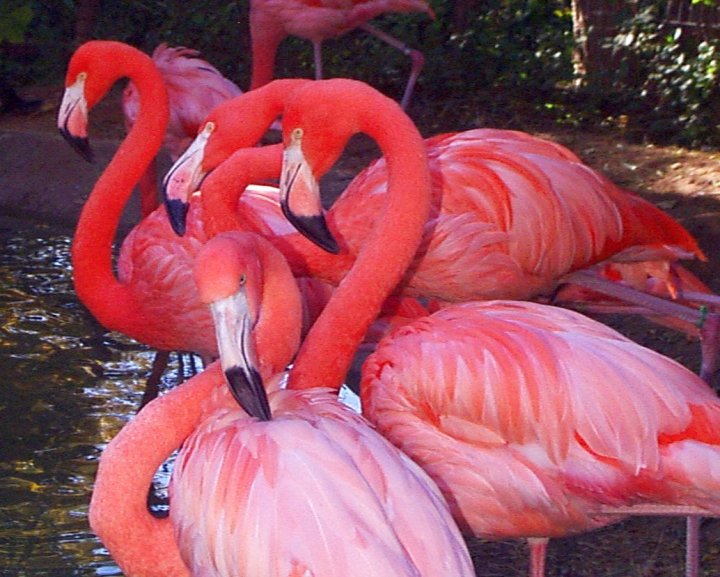 |
 |
| Name: American flamingo |
| Scientific name: Phoeniconais ruber ruber |
| Range: Columbia, Galapagos Islands, Caribbean,Venezuela |
| Habitat: Shallow, salty lagoons and lakes |
| Status: Not threatened |
| Diet in the wild: minute animals and vegetablematter, such as algae and diatoms, or mollusks and crustaceans |
| Diet in the Zoo: Mainly crustaceans (shrimp) |
| Location in the Zoo: Flamingo Exhibit just leftof the bridge entrance |
Physicaldescription: Males are larger than females, but otherwise the samein apperance. The American flamingo may be up to 57 inches in length. The average weight is 6 to 8 pounds. The American flamingo has longlegs that are ideal for wading in water. The color of a flamingo'sfeathers, except for some black wing feathers, varies from bright red topale pink. For example, flamingos of the Caribbean area have coralred feathers, and South American flamingos have pinkish white feathers. Chemicals in the crustaceans are what gives the flamingo its pink color. Coloration of the feet and legs is the same. What appears to be theflamingo's knee is actually its ankle. The American flamingo hasa boomerang shaped beak that can filter out water and trap food. Its beak is referred to as a "Roman nose." The American flamingohas a wingspan of 150 cm (59 in).
General information: Young flamingos leave the nest after five days and formgroups. But the young will return to the nest to feed on fluid producedin the digestive system of the parents. The adult dribbles this fluidfrom its mouth into the youngster's bill. After about two weeks,the young start to find their own food. Flamingos live fifteen totwenty years and longer in captivity.
American flamingos are waders and good swimmers. They congregate in large flocks. Its method of feeding is similarto that of the baleen whales in that the food is taken in along with waterand then the water is expelled through a comb-like structure (lamallae)leaving the food behind.
Specialanatomical, physiological or behavioral adaptations: Theunique bill distinguishes the American flamingo from many other birds. This bent bill is an adaptation for feeding, and designed so that the bentportion is parallel with the bottom of the pond, lake or flats in whichthey are feeding. The legs of the American flamingo are long, whichenables them to wade into much deeper water than most other birds. Webbed feet support them on soft mud.
Flamingos frequently stand on one leg. Being ableto curl the leg under the body, American flamingo keeps the foot warm andconserves body heat. Flamingo stand on one leg in both cool and warmenvironments.
Reproduction: American flamingos reach sexual maturity several yearsafter birth. they begin to breed at about 6 years of age. Breedingcan occur in any season, and a flamingo may breed twice in a year. Breeding and nest building may depend on rainfall and its effect on foodsupply. American flamingos perform structured preening when courtshipbegins. Birds interested in each other will call to one another inunison. Male and female bounding is very strong during breeding season. American flamingos may mate with more than one partner. A flamingo'snest is made of mud, stones, straw and feathers and may be as high as 12inches.
"A single egg is laid on the top of a tall mound thatthe female constructs. At hatching the youngster is covered withwhite down which turns gray in approximately 3 weeks."
Communication: Flamingo vocalizations range from nasal honking to growling. Specific calls can be associated with certain behaviors. Vocalizationsare used in parents chick recognition.
Comments From the ZooKeepers: I was not able to discuss flamingos with anyone at the Fort Worth Zoo. However, I was able to discuss flamingos on the Internet. One of the significant thing that I found out was that flamingos require a diet rich in crustaceans (shrimp) to give their plumage pink. Without it their feathers turn white. Flamingos feed at day and night.
Email: msedenko@yahoo.com | WhoZoo Home Animal Index |
Sourcesand Links: http://www.honoluluzoo.org/american_flamingo.htm
http://www.palmbeachzoo.org/flamingo.htm
The World Book Encyclopedia
http://employeeweb.myxa.com/rrb/Audubon/VolVI/00637.html
Grolier Encyclopedia